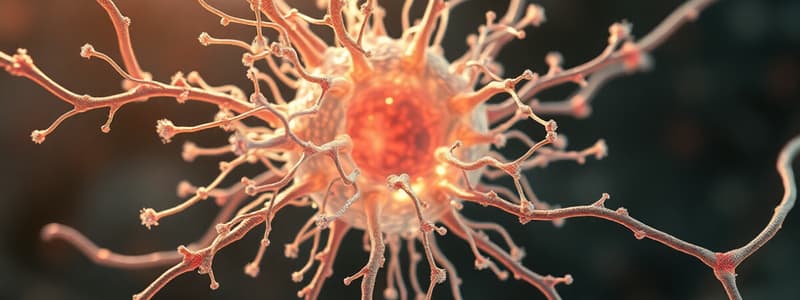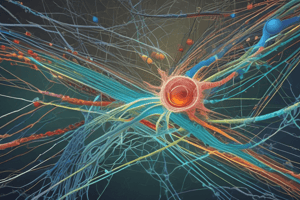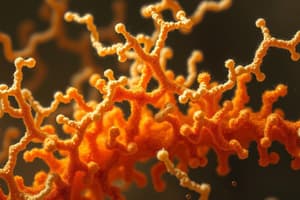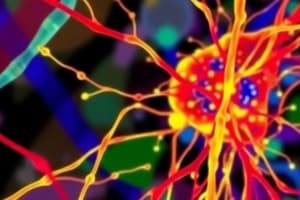Podcast
Questions and Answers
What role do CLASPs play in relation to microtubules at focal adhesions?
What role do CLASPs play in relation to microtubules at focal adhesions?
- They regulate focal adhesion turnover by sequestering GEF-H1.
- They stimulate microtubule rescues to keep ends close to cortical capture sites. (correct)
- They directly nucleate actin filaments through mDia.
- They facilitate the disassembly of microtubules.
Which protein is responsible for capturing microtubules at cortical sites near focal adhesions?
Which protein is responsible for capturing microtubules at cortical sites near focal adhesions?
- RhoA
- Kank proteins
- LL5β (correct)
- mDia
How do microtubules regulate Rho GTPases signaling?
How do microtubules regulate Rho GTPases signaling?
- By delivering relaxation factors to focal adhesions.
- By sequestering GEF-H1, which activates RhoA. (correct)
- By inhibiting the activity of myosin II.
- By promoting the assembly of actin filaments.
What effect does GEF-H1 have on RhoA as a result of microtubule signaling regulation?
What effect does GEF-H1 have on RhoA as a result of microtubule signaling regulation?
Which of the following proteins cooperate to nucleate actin filaments?
Which of the following proteins cooperate to nucleate actin filaments?
Which proteins are responsible for the recycling and delivery of integrins within focal adhesions?
Which proteins are responsible for the recycling and delivery of integrins within focal adhesions?
What role do members of the RHO family of small GTPases play in cellular dynamics?
What role do members of the RHO family of small GTPases play in cellular dynamics?
How do microtubules influence actin dynamics within cells?
How do microtubules influence actin dynamics within cells?
Which component is NOT directly linked to actin filaments at focal adhesions?
Which component is NOT directly linked to actin filaments at focal adhesions?
Which protein recognizes growing microtubule ends and facilitates their assembly along actin fibers?
Which protein recognizes growing microtubule ends and facilitates their assembly along actin fibers?
What is the primary function of vinculin within focal adhesions?
What is the primary function of vinculin within focal adhesions?
What is the significance of the mechanical support provided by the cytoskeleton in cell motility?
What is the significance of the mechanical support provided by the cytoskeleton in cell motility?
Which of the following proteins is involved in linking EB proteins to actin?
Which of the following proteins is involved in linking EB proteins to actin?
What is the role of proteins like talin and vinculin in relation to the actin network?
What is the role of proteins like talin and vinculin in relation to the actin network?
Which mechanosensors are responsible for receiving mechanical stimulation from the extracellular matrix?
Which mechanosensors are responsible for receiving mechanical stimulation from the extracellular matrix?
What is the function of nesprins in the context of the nuclear envelope?
What is the function of nesprins in the context of the nuclear envelope?
What is primarily altered when force transmission affects the cytoskeletal networks?
What is primarily altered when force transmission affects the cytoskeletal networks?
Which proteins are considered major components of the nuclear lamina?
Which proteins are considered major components of the nuclear lamina?
How do LEM domain proteins interact with chromatin in the nucleus?
How do LEM domain proteins interact with chromatin in the nucleus?
The molecular clutch is essential for which type of cellular movement?
The molecular clutch is essential for which type of cellular movement?
What is the relationship between actin networks and the extracellular matrix in terms of cell movement?
What is the relationship between actin networks and the extracellular matrix in terms of cell movement?
What role do actin–microtubule crosslinking proteins play in stabilizing microtubules?
What role do actin–microtubule crosslinking proteins play in stabilizing microtubules?
What is a consequence of the actin cortex acting as a physical barrier for microtubules?
What is a consequence of the actin cortex acting as a physical barrier for microtubules?
How do protein complexes associated with cortical actin networks affect microtubules?
How do protein complexes associated with cortical actin networks affect microtubules?
What function do formins serve in relation to microtubules?
What function do formins serve in relation to microtubules?
What happens during membrane protrusion events driven by actin polymerization?
What happens during membrane protrusion events driven by actin polymerization?
What is a key characteristic of the relationship between actin and microtubules?
What is a key characteristic of the relationship between actin and microtubules?
What is the role of +TIPs in actin-microtubule interactions?
What is the role of +TIPs in actin-microtubule interactions?
Which statement correctly describes the behavior of stiff microtubules in the cytoskeletal framework?
Which statement correctly describes the behavior of stiff microtubules in the cytoskeletal framework?
What role does the extracellular matrix (ECM) play in relation to cytoskeletal components?
What role does the extracellular matrix (ECM) play in relation to cytoskeletal components?
Which cytoskeletal component is primarily involved in forming contractile structures within the cell?
Which cytoskeletal component is primarily involved in forming contractile structures within the cell?
How does the aging process impact cell morphology according to the lecture?
How does the aging process impact cell morphology according to the lecture?
What is the role of actin dynamics in cell morphology and movement?
What is the role of actin dynamics in cell morphology and movement?
What type of actin architecture is commonly found in the lamellipodium of moving cells?
What type of actin architecture is commonly found in the lamellipodium of moving cells?
Which component of the cytoskeleton is primarily responsible for providing mechanical strength to the cell?
Which component of the cytoskeleton is primarily responsible for providing mechanical strength to the cell?
How do extracellular cues affect actin assembly?
How do extracellular cues affect actin assembly?
Which cytoskeletal component is known for facilitating intracellular transport?
Which cytoskeletal component is known for facilitating intracellular transport?
What role does increased ECM stiffness play in progeria cells?
What role does increased ECM stiffness play in progeria cells?
What is the consequence of the depletion of Histone Deacetylase (HDAC6) in senescent renal proximal tubule cells?
What is the consequence of the depletion of Histone Deacetylase (HDAC6) in senescent renal proximal tubule cells?
Which factor is associated with the promotion of RhoA activation in progeria cells?
Which factor is associated with the promotion of RhoA activation in progeria cells?
How are microtubules affected in fibroblasts from Hutchinson-Gilford progeria syndrome (HGPS) when treated with nocodazole?
How are microtubules affected in fibroblasts from Hutchinson-Gilford progeria syndrome (HGPS) when treated with nocodazole?
What significant morphological change is observed in old human dermal fibroblasts compared to young ones?
What significant morphological change is observed in old human dermal fibroblasts compared to young ones?
What does the aspect ratio of a cell indicate?
What does the aspect ratio of a cell indicate?
What is a common consequence of elevated RhoA expression in progeria cells?
What is a common consequence of elevated RhoA expression in progeria cells?
What kind of structural changes occur in the cytoskeleton during cellular senescence?
What kind of structural changes occur in the cytoskeleton during cellular senescence?
Flashcards
What is the cytoskeleton?
What is the cytoskeleton?
The cytoskeleton is a dynamic network of protein filaments that provides structural support, facilitates intracellular transport, connects the cell to its environment, and enables movement.
What are the major components of the cytoskeleton?
What are the major components of the cytoskeleton?
Actin, microtubules and intermediate filaments. Each type of filament has unique properties and functions within the cell.
What is actin?
What is actin?
Actin filaments are thin, flexible polymer chains that form intricate networks responsible for cell shape and movement.
What are microtubules?
What are microtubules?
Signup and view all the flashcards
What are intermediate filaments?
What are intermediate filaments?
Signup and view all the flashcards
How does actin organize in cells?
How does actin organize in cells?
Signup and view all the flashcards
How does actin assemble?
How does actin assemble?
Signup and view all the flashcards
How is actin assembly regulated?
How is actin assembly regulated?
Signup and view all the flashcards
What is the role of EBs in microtubule signaling?
What is the role of EBs in microtubule signaling?
Signup and view all the flashcards
How are microtubules anchored at the cell periphery?
How are microtubules anchored at the cell periphery?
Signup and view all the flashcards
What role do CLASPs play in microtubule dynamics?
What role do CLASPs play in microtubule dynamics?
Signup and view all the flashcards
How do APC and mDia contribute to cytoskeletal organization?
How do APC and mDia contribute to cytoskeletal organization?
Signup and view all the flashcards
How do microtubules influence Rho GTPase signaling?
How do microtubules influence Rho GTPase signaling?
Signup and view all the flashcards
Microtubule Guidance by Actin
Microtubule Guidance by Actin
Signup and view all the flashcards
Microtubule Anchoring and Stabilization
Microtubule Anchoring and Stabilization
Signup and view all the flashcards
Microtubule Growth Barrier
Microtubule Growth Barrier
Signup and view all the flashcards
Microtubule-Mediated Actin Nucleation
Microtubule-Mediated Actin Nucleation
Signup and view all the flashcards
Microtubule Support for Protrusions
Microtubule Support for Protrusions
Signup and view all the flashcards
Actin-Microtubule Crosstalk (Summary)
Actin-Microtubule Crosstalk (Summary)
Signup and view all the flashcards
Context-Dependent Crosstalk
Context-Dependent Crosstalk
Signup and view all the flashcards
Importance of Crosstalk
Importance of Crosstalk
Signup and view all the flashcards
Cooperative actin and microtubule behavior
Cooperative actin and microtubule behavior
Signup and view all the flashcards
RHO GTPases
RHO GTPases
Signup and view all the flashcards
GAP (GTPase-activating protein)
GAP (GTPase-activating protein)
Signup and view all the flashcards
GEF (Guanine nucleotide exchange factor)
GEF (Guanine nucleotide exchange factor)
Signup and view all the flashcards
MAP (Microtubule-associated protein)
MAP (Microtubule-associated protein)
Signup and view all the flashcards
Focal adhesion
Focal adhesion
Signup and view all the flashcards
Dynein
Dynein
Signup and view all the flashcards
KIF1C
KIF1C
Signup and view all the flashcards
Interconnected cell structures
Interconnected cell structures
Signup and view all the flashcards
Progeria stiffening
Progeria stiffening
Signup and view all the flashcards
Progeria's consequences
Progeria's consequences
Signup and view all the flashcards
Accelerated aging
Accelerated aging
Signup and view all the flashcards
Senescent cytoskeleton
Senescent cytoskeleton
Signup and view all the flashcards
Tubule senescence
Tubule senescence
Signup and view all the flashcards
Disrupted connections
Disrupted connections
Signup and view all the flashcards
Morphological aging
Morphological aging
Signup and view all the flashcards
What are focal adhesions (NAs) and what is their role in the cell?
What are focal adhesions (NAs) and what is their role in the cell?
Signup and view all the flashcards
What is the role of the 'molecular clutch' in cell movement?
What is the role of the 'molecular clutch' in cell movement?
Signup and view all the flashcards
What are integrins and what is their role in mechanosensing?
What are integrins and what is their role in mechanosensing?
Signup and view all the flashcards
What is the LINC complex and what is its role in the cell?
What is the LINC complex and what is its role in the cell?
Signup and view all the flashcards
What are nesprins and what is their role in the LINC complex?
What are nesprins and what is their role in the LINC complex?
Signup and view all the flashcards
What are SUN domain proteins and what is their role in the nucleus?
What are SUN domain proteins and what is their role in the nucleus?
Signup and view all the flashcards
What are lamins and what is their role in the nucleus?
What are lamins and what is their role in the nucleus?
Signup and view all the flashcards
What are LEM domain proteins and what is their role in the nucleus?
What are LEM domain proteins and what is their role in the nucleus?
Signup and view all the flashcards
Study Notes
Lecture 2: Cellular Microenvironment & Extracellular Matrix
- Cellular microenvironment is a key focus.
- Matrix components are crucial.
- The 3D organization of matrix components is examined.
- Physicochemical properties of the matrix and their relationship to aging are discussed.
Lecture 3: Cell Morphometric Changes & Cytoskeletal Remodeling
- Cytoskeletal components and their cross-talk regulate cell morphology.
- The extracellular matrix (ECM) dictates the 3D organization of cytoskeletal components.
- Cytoskeletal control of nuclear morphology is studied.
- Cell morphometric and cytoskeletal alterations in aging are explored.
Cytoskeletal Components and Cell Morphology
- Actin, microtubules, and intermediate filaments are key cytoskeletal components.
- These components play critical roles in cell morphology and function.
- The cytoskeleton is a complex network of proteins that provides structural support, facilitates intracellular transport, and enables cell movement.
Cytoskeletal Components (Detailed)
- Actin filaments are involved in polymerization and depolymerization.
- Microtubules are composed of alpha and beta-tubulin dimers.
- Intermediate filaments are composed of various protein subunits.
- The cytoskeleton plays multiple cellular roles, including mechanical strength, intracellular transport, and spatial organization.
Cross-talk Between Actin and Microtubule Cytoskeletons
- Microtubules can be guided by actin bundles.
- Microtubule anchoring and stabilization from actin.
- Actin acts as a physical barrier during microtubule growth.
- Actin nucleation factors may initiate actin filament creation at microtubule ends.
- Mechanical interaction occurs between microtubules and actin during membrane protrusions.
Shared Regulators of Actin and Microtubule Dynamics
- Rho family GTPases are shared regulators of actin and microtubule dynamics.
- Rho GTPases interact with actin- and microtubule-associated proteins.
- Microtubules can influence Rho GTPase activity locally.
Cross-talk Between Actin and Microtubule Cytoskeleton at Focal Adhesions
- Focal adhesions link the extracellular matrix to the actin cytoskeleton.
- Integrins are critical for cell adhesion.
- Recycling and new delivery of integrins depend on microtubule transport mechanisms.
- Microtubule guidance and stabilization, along with signaling complex formation at microtubule ends, impact focal adhesions.
- Micro-tubules are captured at focal adhesion-associated sites via CLASP family members and related proteins.
Cell-Matrix and Cell-Cell Sensing: Common Mechanisms
- Mechanical forces generated by actomyosin interactions are resisted by ECM and cell-cell adhesions.
- This creates a tensional prestress in cells and tissues.
- Actomyosin interactions, ECM, and cell-cell adhesions are crucial for structure and function.
Cell Adhesion to the Matrix Shapes the Cell Nucleus
- Nascent adhesions form at the leading edge of cell protrusions.
- These adhesions involve multiple ligand-bonded integrins and related proteins.
- Adhesome proteins, including vinculin, are recruited for tension- and/or tension-independent processes.
- The actin network interacts with proteins controlling adhesion to convert forces.
Extracellular Matrix Control of Nuclear Morphology and Position
- Mechanical stimulation from the ECM influences cytoskeletal network organization.
- Force transmission alters cytoskeletal network organization via integrins.
- Nesprins and SUN domain proteins integrate cell-matrix forces with nuclear organization.
- The nuclear lamina is crucial for force transmission to the nucleus, influencing gene expression.
Summary of Links Between Inner Nuclear Membrane and Cytoskeleton Interactions
- Diverse factors connect the inner nuclear membrane to the cytoskeleton.
- Kinesin-1, dynein, and other proteins bridge these components.
- Interaction sites exist at microtubules and intermediate fibers for cell cycle progression and other cellular processes.
Experiments to Demonstrate Prestressed Nuclear Architecture in Living Cells
- Experiments demonstrate nuclear architecture impacts force balance in living cells.
- Force balance changes can be studied with different cytoskeletal factors.
- This research focuses on how isolated nuclei respond to force.
Cytoskeleton Organization is Dependent on Cell Microenvironment Interaction
- Cytoskeleton organization shifts in response to varying microenvironments.
- Cell adhesion dynamics are crucial.
- Focal Adhesions, stabilization, and nascent adhesions influence the cytoskeleton.
Fragmentation of Collagen Fibrils within Aged/Photoaged Skin Causes Collapse of Fibroblasts
- Collagen fragmentation correlates with aged skin fibroblast collapse.
- Mechanical tension is crucial for fibroblast health and dermal structure.
- Loss of structure can affect collagen synthesis and fibroblast response.
The Proposed Model for RhoA/Sun2-Mediated Increase of Cytoskeletal Stiffness in Progeria Cells
- The ECM, cytoskeleton, and nucleoskeleton are connected.
- Increased ECM stiffness correlates with RhoA activation and cytoskeleton stiffness.
- RhoA activation correlates with ROS production, inflammation, and DNA damage.
Cellular Senescence is Associated with Reorganization of the Microtubule Cytoskeleton
- HDAC6, Rock1, and γ-tubulin depletion impacts senescent cells.
- Senescent cells show microtubule stabilization, and impaired cell migration.
Imbalanced Nucleo-Cytoskeletal Connections
- Imbalanced nucleo-cytoskeletal connections lead to polarity defects in progeria and aging.
- Nesprin-2G, SUN1, and SUN2 interact with microtubules to affect cell signaling and shape.
Biological Age-Dependent Changes of Cell Morphology
- Cellular morphology alters with age.
- Cell size, shape, and cellular traction force change between young and older cells.
Age-Dependent Alteration of Nuclear Morphology
- Nucleus size and shape change with age in fibroblasts.
- Nucleus area, parameters and aspects are different between young and old cells.
Age-Dependent Alteration of Cell Motility
- Cell motility declines with age and is linked to functional and molecular alterations.
- Cell trajectories and total cell distance correlate with age and cell type.
Heterogeneity in Cellular Mechanical Responses with Aging
- Cellular response and aging have functional heterogeneity.
- Biophysical parameters vary in a group of cells according to chronological age.
Heterogeneity in Cellular Functional Responses with Aging
- Cellular responses display variability with age in physiological processes.
- Diverse molecular responses, including ATP production, influence age-related changes.
Mechanobiological Changes in Aging
- Cellular response to mechanical stress changes with aging.
- ECM, cytoskeleton, and cell mechanics all change in function with age.
- These changes include ECM crosslinking and stiffness, actin polymerization, and cell mechanics.
Lecture 4: Proteostasis
- Proteostasis maintains cellular protein homeostasis efficiently in cells.
- This includes the folding, refolding, and degradation of proteins in cells.
- Cellular processes such as protein homeostasis, folding and degradation are altered by aging and stressors.
Studying That Suits You
Use AI to generate personalized quizzes and flashcards to suit your learning preferences.





